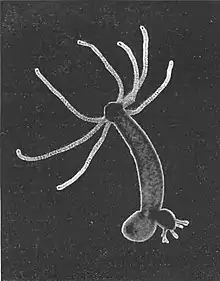List of longest-living organisms
This is a list of the longest-living biological organisms: the individual(s) (or in some instances, clones) of a species with the longest natural maximum lifespans. For a given species, such a designation may include:
- The oldest known individual(s) that are currently alive, with verified ages.
- Verified individual record holders, such as the longest-lived human, Jeanne Louise Calment, or the longest-lived domestic cat, Creme Puff.
The definition of "longest-living" used in this article considers only the observed or estimated length of an individual organism's natural lifespan – that is, the duration of time between its birth or conception, or the earliest emergence of its identity as an individual organism, and its death – and does not consider other conceivable interpretations of "longest-living", such as the length of time between the earliest appearance of a species in the fossil record and the present (the historical "age" of the species as a whole), the time between a species' first speciation and its extinction (the phylogenetic "lifespan" of the species), or the range of possible lifespans of a species' individuals. This list includes long-lived organisms that are currently still alive as well as those that are dead.
Determining the length of an organism's natural lifespan is complicated by many problems of definition and interpretation, as well as by practical difficulties in reliably measuring age, particularly for extremely old organisms and for those that reproduce by asexual cloning. In many cases, the ages listed below are estimates based on observed present-day growth rates, which may differ significantly from the growth rates experienced thousands of years ago. Identifying the longest-living organisms also depends on defining what constitutes an "individual" organism, which can be problematic, since many asexual organisms and clonal colonies defy one or both of the traditional colloquial definitions of individuality (having a distinct genotype and having an independent, physically separate body). Additionally, some organisms maintain the capability to reproduce through very long periods of metabolic dormancy, during which they may not be considered "alive" by certain definitions but nonetheless can resume normal metabolism afterward; it is unclear whether the dormant periods should be counted as part of the organism's lifespan.
Biological immortality
If the mortality rate of a species does not increase after maturity, the species does not age and is said to be biologically immortal. There are numerous plants and animals for which the mortality rate has been observed to actually decrease with age, for all or part of the life cycle.[1] Hydra species were observed for four years without any increase in mortality rate.[2] If the mortality rate remains constant, the rate determines the mean lifespan. The lifespan may be long or short, though the species technically does not "age".
Individuals of other species have been observed to regress to a larval state and regrow into adults multiple times. The hydrozoan species Turritopsis dohrnii (formerly Turritopsis nutricula) is capable of cycling from a mature adult stage to an immature polyp stage and back again. This means no natural limit to its lifespan is known.[3] However, no single specimen has been observed for any extended period, and estimating the age of a specimen is not possible by any known means. At least one other hydrozoan (Laodicea undulata[4]) and one scyphozoan (Aurelia sp.1[5]) can also revert from a medusa stage into a polyp stage.
Similarly, the larvae of skin beetles undergo a degree of "reversed development" when starved, and later grow back to the previously attained level of maturity. This cycle can be repeated many times.[6]
Revived into activity after stasis
If the definition of lifespan does not exclude time spent in metabolically inactive states, many organisms may be said to have lifespans that are millions of years in length. Various claims have been made about reviving bacterial spores to active metabolism after millions of years of dormancy. Spores preserved in amber have been revived after 40 million years,[7] and spores from salt deposits in New Mexico have been revived after 250 million years, making these bacteria by far the longest-living organisms ever recorded.[8] In a related find, a scientist was able to coax 34,000-year-old salt-captured bacteria to reproduce. These results were subsequently duplicated independently.[9]
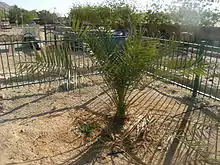
In July 2018, scientists from four Russian institutions collaborating with Princeton University reported that they had analyzed about 300 prehistoric nematode worms recovered from permafrost above the Arctic Circle in Sakha Republic, and that after being thawed, two of the nematodes revived and began moving and eating. One found in a Pleistocene squirrel burrow in the Duvanny Yar outcrop on the Kolyma River was believed to be about 32,000 years old, while the other, recovered in 2015 near the Alazeya River, was dated at approximately 30,000-40,000 years old. These nematodes were believed to be the oldest living multicellular animals on Earth.[10][11]
Like bacterial spores, plant seeds are often capable of germinating after very long periods of metabolic inactivity. A seed from the previously extinct Judean date palm was revived and managed to sprout after nearly 2,000 years. Named "Methuselah", it is currently growing at Kibbutz Keturah, Israel.[12] Similarly, Silene stenophylla was grown from fruit found in an ancient squirrel's cache. The germinated plants bore viable seeds. The fruit was dated at 31,800 ± 300 years old.[13] In 1994, a seed from a sacred lotus (Nelumbo nucifera), dated at roughly 1,300 ± 270 years old, was successfully germinated.[14][15]
During the 1990s, Raul Cano, a microbiologist at California Polytechnic State University, San Luis Obispo, US, reported reviving yeast trapped in amber for 25 million years, although doubts were raised as to its antiquity.[16][17] Cano founded a brewery[18] and crafted an "amber ale" with a 45-million-year-old variant of Saccharomyces cerevisiae.[19]
List of longest-living organisms
Microorganisms
Some endoliths have extremely long lives. In August 2013, researchers reported evidence of endoliths in the ocean floor, perhaps millions of years old, with a generation time of 10,000 years.[20] These are slowly metabolizing and not in a dormant state. Some Actinobacteria found in Siberia are estimated to be half a million years old.[21][22][23]
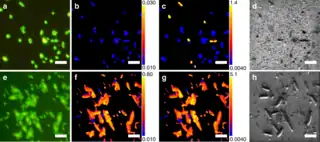
In July 2020, marine biologists reported that aerobic microorganisms (mainly), in "quasi-suspended animation", were found in organically poor sediments, up to 101.5 million years old, 68.9 metres (226 feet) below the seafloor in the South Pacific Gyre (SPG) ("the deadest spot in the ocean"), and could be the longest-living life forms ever found.[24][25]
Clonal plant and fungal colonies
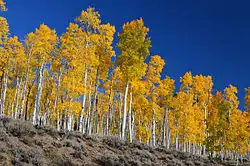
As with all long-lived plant and fungal species, no individual part of a clonal colony is alive (in the sense of active metabolism) for more than a very small fraction of the life of the entire colony. Some clonal colonies may be fully connected via their root systems, while most are not actually interconnected but are nonetheless genetically identical clones which populated an area through vegetative reproduction. Ages for clonal colonies are estimates, often based on current growth rates.[26]
- A huge colony of the sea grass Posidonia oceanica in the Mediterranean Sea near Ibiza, Spain, is estimated to be between 12,000 and 200,000 years old. The maximum age is theoretical, as the region it now occupies was above water at some point between 10,000 and 80,000 years ago.[27][28][29]
- The sole surviving clonal colony of Lomatia tasmanica in Tasmania is estimated to be at least 43,600 years old.[30]
- The Jurupa Oak colony in Riverside County, California, United States, is estimated to be at least 13,000 years old. Other estimates place it at 5,000 to 30,000 years old.[31]
- Eucalyptus recurva clones in Australia have been claimed to be 13,000 years old.[32]
- A box huckleberry bush in Perry County, Pennsylvania, United States, is thought to be around 13,000 years old.[33]
- King Clone is an individual creosote bush (Larrea tridentata) in the Mojave Desert of southern California, United States, estimated at 11,700 years old.[34] Another creosote bush has been said to be 12,150 years old, but this is as yet unconfirmed.
- A Huon pine colony on Mount Read, Tasmania, is estimated at 10,000 years old, with individual specimens living over 3,000 years.[35]
- Old Tjikko, a Norway spruce tree in the county of Dalarna, Sweden, is living on top of roots that have been radiocarbon-dated to 9,550 years old. The tree is part of a clonal colony that was established at the end of the last ice age. Discovered by Professor Leif Kullman of Umeå University, Old Tjikko is small, only 5 m (16 ft) in height.[36][37][38][39]
- Pando is a clonal colony of Populus tremuloides (quaking aspen) trees in south-central Utah, United States, that is estimated to be several thousand years old, possibly as much as 14,000 years.[40] Unlike many other clonal "colonies", the above-ground trunks of these trees remain connected to each other by a single massive subterranean root system.
- "Humongous Fungus", an individual of the clonal subterranean fungal species Armillaria solidipes in Oregon's Malheur National Forest, is thought to be between 2,000 and 8,500 years old.[41][42] Apart from its extreme age, it is also thought to be the world's largest organism by area, at 2,384 acres (965 hectares).
Individual plant specimens
- Methuselah, a Great Basin bristlecone pine (Pinus longaeva) in the White Mountains of California, has been measured by ring count to be 4,852 years old.[43] It is therefore the oldest known living individual non-clonal tree in the world.[44]
- A specimen of Fitzroya cupressoides in Chile was measured by ring count as 3,649 years old, meaning this species has the second-oldest verified age of any non-clonal tree species.[44][45]
- The Cypress of Abarkuh, a Mediterranean cypress (Cupressus sempervirens) in Iran, is estimated to be between 2,000 and 5,000 years old.
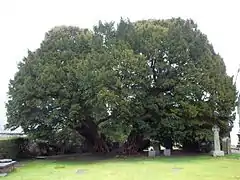
- The Llangernyw Yew, an ancient yew (Taxus baccata) in the churchyard of the village of Llangernyw in North Wales, is believed to be between 4,000 and 5,000 years old.
- The President, located in Sequoia National Park, California, is the oldest known living giant sequoia (Sequoiadendron giganteum) at approximately 3,200 years of age.[46]
- Yareta is a tiny flowering plant in the family Apiaceae native to South America, occurring in the Puna grasslands of the Andes in Peru, Bolivia, northern Chile, and western Argentina between 3,200 and 4,500 metres (10,500 and 14,800 ft) in altitude. Some yaretas may be up to 3,000 years old.[47]
- A Panke baobab (Adansonia digitata) in Zimbabwe was some 2,450 years old when it died in 2011, making it the oldest angiosperm ever documented, and two other trees of the same species – Dorslandboom in Namibia and Glencoe in South Africa – were estimated to be approximately 2,000 years old.[48]
- A sacred fig (Ficus religiosa), the Jaya Sri Maha Bodhi in Anuradhapura, Sri Lanka, is 2308 years old, having been planted in 288 BC.[49] It is the oldest known living human-planted tree in the world.[50]
- The Great sugi of Kayano, the cryptomeria deemed planted by humans in Kaga, Ishikawa, Japan, had an estimated age of 2,300 years in 1928.
- Jōmon Sugi, the cryptomeria naturally grown in Yakushima Island, Kagoshima, Japan, is 2,170 to 7,200 years old.
- A specimen of Lagarostrobos franklinii in Tasmania is thought to be about 2,000 years old.[51]
- The Fortingall Yew, an ancient yew (Taxus baccata) in the churchyard of the village of Fortingall in Perthshire, Scotland, is one of the oldest known individual trees in Europe. Various estimates have put its age between 2,000 and 5,000 years, although it is now believed to be at the lower end of this range.
- Numerous olive trees are purported to be 2,000 years old or older. An olive tree in Ano Vouves, Crete, claiming such longevity, has been confirmed on the basis of tree-ring analysis.[52][53]
- Tāne Mahuta, a kauri tree (Agathis australis) in New Zealand, is believed to be between 1,250 and 2,500 years old. It is the oldest and largest standing kauri tree at present.
- Welwitschia is a monotypic genus of gymnosperm plant, composed solely of the distinct Welwitschia mirabilis. The plant is considered a living fossil. Radiocarbon dating has confirmed that many individuals have lived longer than 1,000 years, and some are suspected to be older than 2,000 years.
Aquatic animals
- Glass sponges found in the East China Sea and Southern Ocean have been determined to be more than 10,000 years old.[54][55][56]
- Specimens of the black coral genus Leiopathes, such as Leiopathes glaberrima, are among the oldest continuously living organisms on the planet: around 4,265 years old.[57]
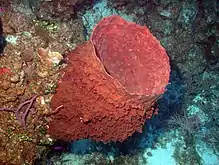
- The giant barrel sponge Xestospongia muta is one of the longest-lived animals, with the largest specimens in the Caribbean estimated to be in excess of 2,300 years old.[58]
- The black coral Antipatharia in the Gulf of Mexico may live more than 2,000 years.[59]
- The Antarctic sponge Cinachyra antarctica has an extremely slow growth rate in the low temperatures of the Southern Ocean. One specimen has been estimated to be 1,550 years old.[60]
- A specimen, "Ming" of the Icelandic cyprine Arctica islandica (also known as an ocean quahog), a mollusk, was found to have lived 507 years.[61] Another specimen had a recorded lifespan of 374 years.[62]
- The tubeworm Escarpia laminata that lives in deep sea cold seeps regularly reaches the age of between 100–200 years, with some individuals determined to be more than 300 years old. It is possible some may live for over 1,000 years.[63][64]
- Greenland shark had been estimated to live to about 200 years, but a study published in 2016 found that a 5.02 m (16.5 ft) specimen was 392 ± 120 years old, resulting in a minimum age of 272 and a maximum of 512.[65][66] That makes the Greenland shark the longest-lived vertebrate.[67]
- The maximum life-span of the freshwater pearl mussel (Margaritifera margaritifera) may be 210–250 years.[68][69][70]
- Some have claimed koi fish can live more than 200 years, for example Hanako, which some claim died at an age of 226 years on July 7, 1977, but this age estimate is based on a scale estimate,[71][72] is inadequate, and is not scientifically accepted.[73]
- Some confirmed sources estimate bowhead whales to have lived at least to 211 years of age, making them the oldest mammals.[74]
- Rougheye rockfish can reach an age of 205 years.[75]
- Specimens of the Red Sea urchin Strongylocentrotus franciscanus have been found to be over 200 years old.[76]
- Many sub-families of the marine fish Oreosomatidae, including the Allocyttus, Neocyttus, and Pseudocyttus (collectively referred to as the Oreos) have been reported to live up to 170 years, based on otolith-increment estimates and radiometric dating[77][78][79]
- The deepsea hydrocarbon seep tubeworm Lamellibrachia luymesi (Annelida, Polychaeta) lives for more than 170 years.[80]
- Geoduck, a species of saltwater clam native to the Puget Sound, have been known to live more than 160 years.[81][82]
- A Swedish man claimed that a European eel named Åle was 155 years old when it died in 2014. If correct, it would have been the world's oldest, having been hatched in 1859.[83]
- Orange roughy, also known as deep sea perch, can live up to 149 years.[84]
- George the lobster was estimated to be about 140 years old by PETA in January 2009.[85]
- In 2012, a sturgeon estimated to be 125 years old was caught in a river in Wisconsin.[86]
- Tardigrades, capable of cryptobiosis, have been shown to survive nearly 120 years in a dry state.[87]
- The Bigmouth Buffalo (Ictiobus cyprinellus), a freshwater fish in the Family Catostomidae, has a maximum longevity of at least 112 years based on otolith annulus counts and bomb radiocarbon dating.[88]
- A killer whale of the "Southern Resident Community" identified as J2 or Granny was estimated by some researchers to have been approximately 105 years old at her death in 2017; however, other dating methods estimated her age as 65–80.[89][90]
- A goldfish named Tish lived for 43 years after being won at a fairground in 1956.[91]
Humans
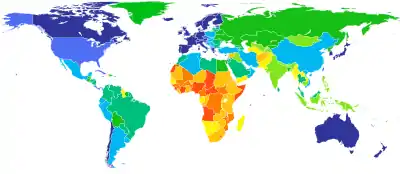
|
>80
77.5–80
75–77.5
72.5–75
70–72.5 |
67.5–70
65–67.5
60–65
55–60
50–55 |
- Jeanne Calment, a French woman, lived to the age of 122 years, 164 days, making her the oldest fully documented human who has ever lived. She died on August 4, 1997.[92]
- Jiroemon Kimura (†116 years, 54 days) was the oldest verified man and died on 12 June 2013.
- The oldest known person alive today is Kane Tanaka at 118 years, 35 days (born 2 January 1903).[93]
These are single examples; for a broader view, see life expectancy (includes humans).
Other terrestrial and pagophilic animals
Adwaita, an Aldabra giant tortoise, died at an estimated age of 255 in March 2006 in Zoological Garden, Alipore, Kolkata, India.[94] If verified, it will have been the oldest terrestrial animal in the world.
- Tu'i Malila, a radiated tortoise, died at an age of 188 years in May 1966, at the time the oldest verified vertebrate.[95] This tortoise was born in 1777.
- Jonathan, a Seychelles giant tortoise living on the island of Saint Helena, is reported to be about 189 years old, and may, therefore, be the oldest currently living terrestrial animal if the claim is true.[96]
- Harriet, a Galápagos tortoise, died at the age of 175 years in June 2006.[97]
- Timothy, a greek tortoise, born in Turkey died at an age of 165 years on 3 April 2004 in the UK.[98]
- The tuatara, a lizard-like reptile native to New Zealand, can live well over 100 years. Henry, a tuatara at the Southland Museum in New Zealand, mated for the first time at the estimated age of 111 years in 2009 with an 80-year-old female and fathered 11 baby tuatara.[99]
- Dakshayani, a female Asian elephant, initially owned by the Travancore royal family and later by the Travancore Devaswom Board, was 88 or 89 years old when she died on February 5, 2019.[100] She is believed to be the oldest elephant in captivity in Asia and was nicknamed ‘Gaja Muthassi’ (grandmother of elephants).
- Lin Wang, an Asian elephant, was the oldest elephant in the Taipei Zoo. He was born on January 18, 1917, and died on February 26, 2003, at 86 years, surpassing the previous record of 84. Normally, elephants live up to 50 years, while their maximum lifespan is generally estimated at 70.
- Hakuna, an African slender-snouted crocodile was gifted to Blijdorp Zoo in Rotterdam, Netherlands in 1929 by singer and dancer Josephine Baker, He lived there for 85 years until he died on 19 February 2015, He is the oldest crocodile in captivity ever.[101]
- A greater flamingo named Greater died at Adelaide Zoo in January 2014 at the age of at least 83.[102]
- Cookie (hatched June 30, 1933), an Australian-born Major Mitchell's cockatoo at Brookfield Zoo, Illinois, was the oldest member of his species in captivity, and died in August 2016 at a verified age of 83.[103]
- Muja, an American alligator at Belgrade Zoo, is considered the oldest alligator in the world.[104] Muja is more than 80 years old.[105]
- Thaao, an Andean condor, died at the age of 80.[106]
- A female Laysan albatross named Wisdom successfully laid an egg at Midway Atoll in December 2016, at the age of 66. As of 2017, she is the oldest known wild bird in the world.[107]
- The oldest living horse on record, Ol' Billy, was allegedly born in the year 1760 in London, England. Bill died in 1822 at the age of 62 years. Henry Harrison, a resident of London during the time, had also allegedly known Ol' Billy for 59 years until Bill's death.[108]
- Nonja, a Sumatran orangutan, died at the age of 55 years in December 2007. She was claimed to be the oldest-living orangutan of her species.[109]
- The oldest bear on record was Andreas, a European brown bear, living in the ARCTUROS bear sanctuary in northern Greece.[110] He was at least 50 years old at the time of his death.
- On May 27, 1983 a splendor beetle emerged from a staircase in Essex, UK after at least 47 years as a larva.[111]
- A wild-born black rhino named Elly was the oldest in North America at an estimated 45 years of age, and resided in California's San Francisco Zoo from April 1974 until passing in May 2017.[112]
- The oldest living spider, named Number 16 by researchers, was a 43-year-old female Gaius villosus armored trapdoor spider, at the North Bungulla Reserve, Tammin, Western Australia.[113]
- Debby, the polar bear, an inhabitant of the Assiniboine Park Zoo in Winnipeg, Canada, was the oldest polar bear and third-oldest bear species on record when she died in 2008, at the age of 42 years.[114]
- The oldest recorded bat, a Brandt's bat, is at least 41 years old.[115]
- Creme Puff, a cat owned by Jake Perry of Austin, Texas, was born August 3, 1967, and died three days after her 38th birthday on August 6, 2005.[116]
- The oldest goat was McGinty who lived to the age of 22 years and 5 months until her death in November 2003 on Hayling Island, UK.[117]
- A wild rabbit named Flopsy was caught on August 6, 1964 and died 18 years and 10 months later in Tasmania, Australia.[117]
- A bearded dragon owned by Nik Vernon, was 16 years 129 days old when he died on Dec 2, 2013.[118]
- The oldest gerbil was a Mongolian gerbil named Sahara, she was born in May 1973 and died on 4 October 1981 aged 8 years and 4 months.[119]
- Fritzy, a house mouse, born on 11 September 1977 and died on 24 April 1984, 7 years and 7 months after he was born.[120]
- A hamster owned by Karen Smeaton in Tyne & Wear, UK, reached 4 years and 6 months.[119]
See also
Further reading
- Rachel Sussman (2014). The Oldest Living Things in the World. Chicago: University of Chicago Press. ISBN 9780226057507.
References
- Ainsworth, C; Lepage, M (2007). "Evolution's greatest mistakes". New Scientist. 195 (2616): 36–39. doi:10.1016/S0262-4079(07)62033-8.
- Martínez, Daniel E. (1998). "Mortality patterns suggest lack of senescence in Hydra". Experimental Gerontology. 33 (3): 217–225. CiteSeerX 10.1.1.500.9508. doi:10.1016/S0531-5565(97)00113-7. PMID 9615920. S2CID 2009972.
- Gilbert, Scott F. (2010). "The Immortal Life Cycle of Turritopsis". Developmental Biology (9th ed.). Sinauer Associates. ISBN 978-0-878-93384-6. Archived from the original on 2013-06-10.
- De Vito; et al. (2006). "Evidence of reverse development in Leptomedusae (Cnidaria, Hydrozoa): the case of Laodicea undulata (Forbes and Goodsir 1851)". Marine Biology. 149 (2): 339–346. doi:10.1007/s00227-005-0182-3. S2CID 84325535.
- He; et al. (2015-12-21). "Life Cycle Reversal in Aurelia sp.1 (Cnidaria, Scyphozoa)". PLOS ONE. 10 (12): e0145314. Bibcode:2015PLoSO..1045314H. doi:10.1371/journal.pone.0145314. PMC 4687044. PMID 26690755.
- Beck, SD; Bharadwaj, RK (1972). "Reversed development and cellular aging in an insect". Science. 178 (4066): 1210–1211. Bibcode:1972Sci...178.1210B. doi:10.1126/science.178.4066.1210. PMID 4637808. S2CID 34101370.
- Cano, RJ; Borucki, MK (19 May 1995). "Revival and identification of bacterial spores in 25- to 40-million-year-old Dominican amber". Science. 268 (5213): 1060–1064. Bibcode:1995Sci...268.1060C. doi:10.1126/science.7538699. PMID 7538699.
- Vreeland, Russell H.; Rosenzweig, William D.; Powers, Dennis W. (2000-10-19). "Isolation of a 250 million-year-old halotolerant bacterium from a primary salt crystal". Nature. 407 (6806): 897–900. doi:10.1038/35038060. ISSN 1476-4687. PMID 11057666. S2CID 9879073.
- "34,000 Year Old Organisms Found Buried Alive!". Yahoo News. January 13, 2011. Retrieved January 31, 2013.
- Shatilovich, A. V.; Tchesunov, A. V.; Neretina, T. V.; Grabarnik, I. P.; Gubin, S. V.; Vishnivetskaya, T. A.; Onstott, T. C.; Rivkina, E. M. (2018-05-01). "Viable Nematodes from Late Pleistocene Permafrost of the Kolyma River Lowland". Doklady Biological Sciences. 480 (1): 100–102. doi:10.1134/S0012496618030079. ISSN 1608-3105. PMID 30009350. S2CID 49743808.
- "Worms frozen in permafrost for up to 42,000 years come back to life". Retrieved July 27, 2018.
- Erlanger, Steven (June 12, 2005). "After 2,000 years, a seed from ancient Judea sprouts". The New York Times.
- Yashina, S.; Gubin, S.; Maksimovich, S.; Yashina, A.; Gakhova, E.; Gilichinsky, D. (2012). "Regeneration of whole fertile plants from 30,000-y-old fruit tissue buried in Siberian permafrost". Proceedings of the National Academy of Sciences. 109 (10): 4008–13. Bibcode:2012PNAS..109.4008Y. doi:10.1073/pnas.1118386109. PMC 3309767. PMID 22355102.
- Shen-Miller; Mudgett, M. B.; William Schopf, J.; Clarke, S.; Berger, R. (1995). "Exceptional seed longevity and robust growth: Ancient sacred lotus from China". American Journal of Botany. 82 (11): 1367–1380. doi:10.2307/2445863. JSTOR 2445863.
- Shen-Miller; et al. (2002). "Long-living lotus: germination and soil gamma-irradiation of centuries-old fruits, and cultivation, growth, and phenotypic abnormalities of offspring". American Journal of Botany. Retrieved 2010-02-03.
Sacred lotus (Nelumbo nucifera) has been cultivated as a crop in Asia for thousands of years. A [roughly 1300-year-old] lotus fruit, recovered from an originally cultivated but now dry lakebed in northeastern China, is the oldest germinated and directly 14C-dated fruit known. In 1996, we traveled to the dry lake at Xipaozi Village, China, the source of the old viable fruits.
- Brüssow, Harald (2020). "Bioarchaeology: a profitable dialogue between microbiology and archaeology". Microbial Biotechnology. 13 (2): 406–409. doi:10.1111/1751-7915.13527. ISSN 1751-7915. PMC 7017812. PMID 32053292.
- Nick Wilson (January 18, 2011). "Poly professor brews beer with 45-million-year-old yeast". Retrieved November 16, 2015.
- "The Story - nature finds a way". Fossil Fuels Brewing Co. Archived from the original on 2020-01-31.
- Erin Biba (July 20, 2009). "Amber Ale: Brewing Beer From 45-Million-Year-Old Yeast". Retrieved November 16, 2015.
- Bob Yirka Aug 29, 2013
- Sussman: Oldest Plants, The Guardian, 2 May 2010
- "Archived copy". Archived from the original on 2018-07-13. Retrieved 2018-07-13.CS1 maint: archived copy as title (link)
- Willerslev, Eske; Froese, Duane; Gilichinsky, David; Rønn, Regin; Bunce, Michael; Zuber, Maria T.; Gilbert, M. Thomas P.; Brand, Tina; Munch, Kasper; Nielsen, Rasmus; Mastepanov, Mikhail; Christensen, Torben R.; Hebsgaard, Martin B.; Johnson, Sarah Stewart (September 4, 2007). "Ancient bacteria show evidence of DNA repair". Proceedings of the National Academy of Sciences. 104 (36): 14401–14405. Bibcode:2007PNAS..10414401J. doi:10.1073/pnas.0706787104. PMC 1958816. PMID 17728401.
- Wu, Katherine J. (28 July 2020). "These Microbes May Have Survived 100 Million Years Beneath the Seafloor - Rescued from their cold, cramped and nutrient-poor homes, the bacteria awoke in the lab and grew". Retrieved 31 July 2020.
- Morono, Yuki; et al. (28 July 2020). "Aerobic microbial life persists in oxic marine sediment as old as 101.5 million years". Nature Communications. 11 (3626): 3626. doi:10.1038/s41467-020-17330-1. PMC 7387439. PMID 32724059.
- Gymnosperm Database (2 January 2007). "How Old Is That Tree?". Archived from the original on 2012-09-27. Retrieved 2006-07-25.
- Ibiza Spotlight (28 May 2006). "Ibiza's Monster Marine Plant". Archived from the original on 2006-08-27. Retrieved 2007-05-09.
- Pearlman, Jonathan (2012-02-07). "'Oldest living thing on earth' discovered". The Daily Telegraph. London.
- Arnaud-Haond, Sophie; Duarte, Carlos M.; Diaz-Almela, Elena; Marbà, Núria; Sintes, Tomas; Serrão, Ester A. (February 1, 2012). Bruun, Hans Henrik (ed.). "Implications of Extreme Life Span in Clonal Organisms: Millenary Clones in Meadows of the Threatened Seagrass Posidonia oceanica". PLOS ONE. 7 (2): e30454. Bibcode:2012PLoSO...730454A. doi:10.1371/journal.pone.0030454. PMC 3270012. PMID 22312426.
- Discovery Channel (21 October 1996). "Tasmanian bush could be oldest living organism". Archived from the original on July 23, 2006. Retrieved 2006-07-25.
- Michael Reilly (December 23, 2009). "Ancient tree (almost) older than dirt". Discovery News. Retrieved Jan 15, 2015.
- "Oldest Living Organism: Ancient Bacteria". Extreme Science. Archived from the original on February 5, 2010. Retrieved January 31, 2013.
- McMillen, Nathan D. (Fall 2010). "Pennsylvania's Oldest Citizen". Archived from the original on November 22, 2017.
- "Plant Hall of Fame". Fact Monster. Retrieved January 31, 2013.
- "Native Conifers of Tasmania". Paks and Wildlife Service, Tasmania. Archived from the original on 2012-09-02. Retrieved 2008-05-06.
- "Press release from Umeå University". Info.umu.se. Archived from the original on 2008-04-20. Retrieved 2010-03-17.
- "Swedish spruce may be world's oldest living tree". Reuters. April 11, 2008.
- "Oldest Living Tree Found in Sweden". News.nationalgeographic.com. Retrieved 2010-03-17.
- "World's oldest living tree discovered in Sweden". Swedish Research Council. 16 April 2008.
- Rogers, Paul C.; McAvoy, Darren J. (2018-10-17). Heinze, Berthold (ed.). "Mule deer impede Pando's recovery: Implications for aspen resilience from a single-genotype forest". PLOS ONE. 13 (10): e0203619. doi:10.1371/journal.pone.0203619. ISSN 1932-6203. PMC 6192553. PMID 30332420.
- "Humongous Fungus A New Kind Of Individual". Science Daily. March 25, 2003.
- "Strange but True: The Largest Organism on Earth Is a Fungus". Scientific American. October 4, 2007.
- "Pinus longaeva". Gymnosperm Database. March 15, 2007. Retrieved 2008-06-20.
- "Rocky Mountain Tree-Ring Research, OLDLIST". Retrieved January 6, 2013.
- Lara, Antonio; Villalba, Ricardo (21 May 1993). "A 3620-Year Temperature Record from Fitzroya cupressoides Tree Rings in Southern South America". Science. 260 (5111): 1104–1106. Bibcode:1993Sci...260.1104L. doi:10.1126/science.260.5111.1104. PMID 17806339. S2CID 46397540.
- Quammen, David (December 2012). "Forest Giant". National Geographic. Archived from the original on June 27, 2017. Retrieved 2017-11-21.
- Ralph, Carol Pearson (March 1978). "Observations on Azorella compacta (Umbelliferae), a Tropical Andean Cushion Plant". Biotropica. 10 (1): 62–67. doi:10.2307/2388107. JSTOR 2388107. (subscription required)
- Patrut, Adrian; et al. (2018). "The demise of the largest and oldest African baobabs". Nature Plants. 4 (7): 423–426. doi:10.1038/s41477-018-0170-5. hdl:2263/65292. PMID 29892092. S2CID 47017569.
- Shanika Sriyananda (2011-07-03). "Caring for the Jaya Sri Maha Bodhi". Archived from the original on 2013-04-13. Retrieved 2012-01-24.
- "The Coming of the Bodhi Tree to Lanka". www.srimahabodhi.org.
- "Botanical Record Breakers: Amazing Trivia About Plants". Waynesword.palomar.edu. Archived from the original on 2010-12-19. Retrieved 2010-03-17.
- Rackham, Oliver; Moody, J (1996). The Making of the Cretan Landscape.
- Riley, FR (2002). "Olive Oil Production on Bronze Age Crete: Nutritional properties, Processing methods, and Storage life of Minoan olive oil". Oxford Journal of Archaeology. 21 (1): 63–75. doi:10.1111/1468-0092.00149.
- "Glass sponge as a living climate archive". PhysOrg. April 5, 2012. Retrieved 9 January 2017.
- "AnAge entry for Scolymastra joubini". Human Ageing Genomic Resources. AnAge Database of Animal Ageing and Longevity. Retrieved 9 January 2017.
- Robert Lloyd (March 16, 2012). "Television review: 'Frozen Planet' on Discovery Channel". Los Angeles Times.
- Graczyk, Michael (2009-03-25). "Scientists ID living coral as 4,265 years old". Associated Press. Archived from the original on 2009-04-01.
- McMurray, SE; Blum, JE; Pawlik, JR (2008). "Redwood of the reef : growth and age of the giant barrel sponge Xestospongia muta in the Florida Keys". Marine Biology. 155 (2): 159–171. doi:10.1007/s00227-008-1014-z. S2CID 55834932.
- "2,000 Year-old Deep-sea Black Corals call Gulf of Mexico Home". U.S. Geological Survey. March 30, 2011. Retrieved January 31, 2013.
- "AnAge entry for Cinachyra antarctica". Genomics.senescence.info. Retrieved 2010-03-17.
- Butler, Paul; AD Wanamaker; JD Scourse; CA Richardson; DJ Reynolds (2012). "Variability of marine climate on the North Icelandic Shelf in a 1357-year proxy archive based on growth increments in the bivalve Arctica islandica". Palaeogeography, Palaeoclimatology, Palaeoecology. 373: 141–151. Bibcode:2013PPP...373..141B. doi:10.1016/j.palaeo.2012.01.016.
- Schöne; Fiebig, J; Pfeiffer, M; Gleb, R; Hickson, J; Johnson, A; Dreyer, W; Oschmann, W (2005). "Climate records from a bivalved Methuselah". Palaeogeography, Palaeoclimatology, Palaeoecology. 228 (1–2): 130–148. Bibcode:2005PPP...228..130S. doi:10.1016/j.palaeo.2005.03.049.
- Durkin, Alanna; Fisher, Charles R.; Cordes, Erik E. (8 July 2017). "Extreme longevity in a deep-sea vestimentiferan tubeworm and its implications for the evolution of life history strategies". The Science of Nature. 104 (7–8): 63. Bibcode:2017SciNa.104...63D. doi:10.1007/s00114-017-1479-z. PMID 28689349. S2CID 11287549.
- Gruber, Karl (20 July 2017). "Giant deep-sea worms may live to be 1000 years old or more". New Scientist.
- Pennisi, Elizabeth (11 August 2016). "Greenland shark may live 400 years, smashing longevity record". Science. Retrieved 11 August 2016.
- Nielsen, Julius; Hedeholm, Rasmus B.; Heinemeier, Jan; Bushnell, Peter G.; Christiansen, Jørgen S.; Olsen, Jesper; Ramsey, Christopher Bronk; Brill, Richard W.; Simon, Malene (2016-08-12). "Eye lens radiocarbon reveals centuries of longevity in the Greenland shark (Somniosus microcephalus)". Science. 353 (6300): 702–704. Bibcode:2016Sci...353..702N. doi:10.1126/science.aaf1703. ISSN 0036-8075. PMID 27516602. S2CID 206647043.
- Varandani, Suman (14 December 2017). "512-Year-Old Shark, Believed To Be Oldest Living Verbrate, Found In North Atlantic". International Business Times. Retrieved 14 December 2017.
- Ziuganov, V., San Miguel, E., Neves, R.J., Longa, A., Fernandez, C., Amaro, R., Beletsky, V., Popkovitch, E., Kaliuzhin, S., Johnson, T. (2000). "Life span variation of the freshwater pearlshell: a model species for testing longevity mechanisms in animals". Ambio. XXIX (2): 102–105. doi:10.1579/0044-7447-29.2.102. S2CID 86366534.CS1 maint: multiple names: authors list (link)
- Зюганов В.В. (2004). "Арктические долгоживущие и южные короткоживущие моллюски жемчужницы как модель для изучения основ долголетия". Успехи геронтол. 14: 21–31.
- Helama S.; Valovirta I. (2008). "The oldest recorded animal in Finland: ontogenetic age and growth in Margaritifera margaritifera (L. 1758) based on internal shell increments" (PDF). Memoranda Soc. Fauna Flora Fennica. 84: 20–30.
- Koshihara, Komei (1966). "The Story of Hanako". NHK. Archived from the original on August 8, 2007.
- Barton, Laura (2007-04-12). "Laura Barton on the lifespan of pets". The Guardian. London. Retrieved 2009-04-11.
- Brown, Paul; Green, Corey; Sivakumaran, K. P.; Stoessel, Daniel; Giles, A. (2004). "Validating Otolith Annuli for Annual Age Determination of Common Carp". Transactions of the American Fisheries Society. 133 (1): 190–196. doi:10.1577/T02-148. ISSN 1548-8659.
- Alaska Science Forum (15 February 2001). "Bowhead Whales May Be the World's Oldest Mammals". Archived from the original on 2009-12-09. Retrieved 2006-07-25.
- Cailliet, G.M.; Andrews, A.H.; Burton, E.J.; Watters, D.L.; Kline, D.E.; Ferry-Graham, L.A. (2001). "Age determination and validation studies of marine fishes: do deep-dwellers live longer?". Exp. Gerontol. 36 (4–6): 739–764. doi:10.1016/S0531-5565(00)00239-4. PMID 11295512. S2CID 42894988.
- Ebert, TA; Southon, JR (2003). "Red sea urchins can live over 100 years: confirmation with A-bomb 14carbon – Strongylocentrotus franciscanus". Fishery Bulletin. 101 (4): 915–922.
- "Allocyttus verrucosus". The Moirai – Aging Research. 2016-09-11. Retrieved 2016-11-20.
- "Pseudocyttus maculatus". The Moirai – Aging Research. 2016-10-05. Retrieved 2016-11-20.
- "Neocyttus rhomboidalis". The Moirai – Aging Research. 2016-10-03. Retrieved 2016-11-20.
- Sharmishtha, D.; Miles, L. L.; Barnabei, M.S.; Fisher, C. R. (2006). "The hydrocarbon seep tubeworm Lamellibrachia luymesi primarily eliminates sulfate and hydrogen ions across its roots to conserve energy and ensure sulfide supply". Journal of Experimental Biology. 209 (19): 3795–3805. doi:10.1242/jeb.02413. PMID 16985196.
- "Geoduck". BC Seafood Online. Archived from the original on September 17, 2011.
- MacDonald, Colin (August 21, 2004). "Cashing in on geoducks – once chowder fodder, the giant clam can fetch up to $24 a pop". Seattle Post-Intelligencer. Archived from the original on 2013-05-18. (subscription required)
- David Harding (9 August 2014). "World's oldest eel dies aged 155, Sweden mourns". The New York Daily News. Retrieved 1 April 2015.
- Fenton, G.E; Short, S.A.; Ritz, D.A. (June 1991). "Age determination of orange roughy, Hoplostethus atlanticus (Pisces: Trachichthyidae) using 210 Pb: 226 Ra disequilibria". Marine Biology. 109 (2): 197–202. doi:10.1007/BF01319387. ISSN 0025-3162. S2CID 84942308.
- "George the giant lobster liberated from restaurant". CNN. January 10, 2009. Retrieved January 31, 2013.
- "Wisconsin DNR catches and tags record 125-year-old sturgeon that's bigger than linebacker". Star Tribune. April 12, 2012. Archived from the original on 2012-04-13. Retrieved January 31, 2013.
- Guidetti, R. & Jönsson, K.I. (2002). "Long-term anhydrobiotic survival in semi-terrestrial micrometazoans". Journal of Zoology. 257 (2): 181–187. CiteSeerX 10.1.1.630.9839. doi:10.1017/S095283690200078X.
- Lackmann, Alec R.; Andrews, Allen H.; Butler, Malcolm G.; Bielak-Lackmann, Ewelina S.; Clark, Mark E. (2019-05-23). "Bigmouth Buffalo Ictiobus cyprinellus sets freshwater teleost record as improved age analysis reveals centenarian longevity". Communications Biology. 2 (1): 197. doi:10.1038/s42003-019-0452-0. ISSN 2399-3642. PMC 6533251. PMID 31149641.
- TEGNA. "Oldest Southern Resident killer whale considered dead". KING. Retrieved 2017-01-03.
- Podt, Annemieke (2016-12-31). "Orca Granny: was she really 105?". Retrieved September 11, 2017.
- Guinness world records 2001. Jim Pattison Group. 2000. p. 163. ISBN 9780553583755.
- Guinness World Records, 1999 edition, p. 102, ISBN 0-85112-070-9.
- "GRG World Supercentenarian Rankings List". Validated Living. Missing or empty
|url=(help) - BBC News – South Asia (2006-03-23). "'Clive of India's' tortoise dies". BBC News. BBC Online. Retrieved 2014-01-23.
- "Week In Science: 6/23 – 6/29". Seed.
- "Meet Jonathan, St Helena's 182-year-old giant tortoise". BBC News. 13 March 2014.
- "Harriet the Tortoise dies at 175". BBC News. 23 June 2006.
- "Timmy the tortoise dies aged 160". BBC News. April 7, 2004. Retrieved January 31, 2013.
- Bai, Nina (January 26, 2009). "111-Year-Old Reptile Becomes a Dad After Tumor Surgery". Discover. Retrieved January 31, 2013.
- Staff Reporter (2019-02-06). "Dakshayani, oldest Asian elephant, dies". The Hindu. ISSN 0971-751X. Retrieved 2020-04-08.
- Guiness world records 2017. Jim Pattison Group. 2016. p. 54. ISBN 9781904994862.
- "Greater, the 83-year-old Adelaide Zoo flamingo, dies". The Australian. 31 January 2014. Retrieved 31 January 2014.
- "Cookie the Cockatoo at Brookfield Zoo dies". Chicago Tribune. Retrieved 7 September 2016.
- "Elderly alligator recovers after life-saving surgery". February 24, 2012. Archived from the original on September 8, 2015. Retrieved August 28, 2015.
- Lazarević, Z. "Najstariji aligator na svetu živi u Beogradu". Blic.rs.
- Burgeson, John (January 26, 2010). "Beardsley Zoo's Andean condor, world's oldest, dead at 80". The Connecticut Post. Retrieved January 31, 2013.
- Fears, Darryl. "Wisdom the albatross, the oldest known wild bird, just laid an egg at age 66". washingtonpost.com. Retrieved 3 Feb 2017.
- Meier, Allison (4 March 2013). "Morbid Monday: The Split Head of Old Billy, the World's Oldest Horse". Atlas Obscura. Retrieved 17 November 2013.
- "'World's oldest' orang-utan dies". bbc.co.uk. BBC News. 2002-12-31. Retrieved 2012-03-18.
- "Andreas – oldest bear in the world dies in Greek sanctuary". The Bear Sanctuary.
- Guinness world records 2005. Jim Pattison Group. 2004. p. 69. ISBN 9780851121925.
- Har, Janie (Jan 1, 2016). "Oldest black rhinoceros in North America turns 45". Associated Press.
- Mason, Leanda Denise; Wardell-Johnson, Grant; Main, Barbara York (2018). "The longest-lived spider: mygalomorphs dig deep, and persevere". Pacific Conservation Biology. 24 (2): 203–206. doi:10.1071/PC18015.
- Tributes pour in after oldest polar bear dies in Winnipeg from CBC.ca; published November 18, 2008; retrieved September 27, 2014
- Locke, Robert (2006). "Longest-lived mammals offer clues to better aging in humans". BATS Magazine. Austin, TX: Bat Conservation International. Retrieved April 10, 2017.
- Guinness World Records 2010. Bantam; Reprint edition. 2010. p. 320. ISBN 978-0-553-59337-2.
The oldest cat ever was Creme Puff, who was born on August 3, 1967 and lived until August 6, 2005 – 38 years and 3 days in total.
- Guinness world records 2005. Jim Pattison Group. 2004. p. 73. ISBN 9780851121925.
- Guinness world records 2015. Jim Pattison Group. 2014. p. 64. ISBN 9781101883808.
- Guinness world records 2014. Jim Pattison Group. 2013. p. 43. ISBN 9781908843159.
- "Oldest Mouse". Guinness World Records. Retrieved 29 October 2020.
